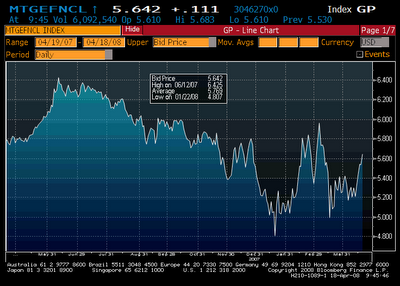With all the cheery talk about how our credit crisis is a thing of the past, mortgage rates, as reader Scott reminds us, are moving up again. From his message:
You’ll recall that some time over the last month or so, bullish commentators noted that with mortgage rates falling, resets of ARMs were no longer a problem. (Note in this regard that in addition to resets, so-called recasts—option arms that have reached the limit of their negative amortization, the point at which the principal has climbed to its maximum allowable amount, and the mortgage morphs into a fixed rate at a much higher payment schedule [This is what Wamu, First Fed, Downey, and Golden West/Wachovia wrote tons of] are an additional huge problem irrespective of where mortgage rates are.) In any event, mortgage rates have skyrocketed yet again.
More commentary from the Financial Times:
US mortgage rates soared this week after a dramatic sell-off in the Treasury market that hit housing sector recovery hopes even as it suggested investors were growing more confident in the medium-term US economic outlook.
The yield on the 10-year Treasury rose as high as 3.85 per cent on Friday from less than 3.50 per cent last week as investors sold bonds on expectations that the Federal Reserve could soon end its rate-cutting cycle…
Rates on 30-year fixed-rate mortgages rose to 5.87 per cent from 5.63 per cent a week ago, Bankrate.com said. Jumbo mortgages, those of more than $417,000, rose to 7.19 per cent from 7.06 per cent.
“The back-up in yields is a concern as it will damage the economic outlook,” said Jane Caron, strategist at Dwight Asset Management.
The three-month London interbank offered rate – Libor – increased to 2.91 per cent from 2.71 per cent this week, indicating underlying stress in the financial system.
Stocks rallied, said Anthony Conroy, head of equity trading at BNYConvergEx, because “the equity market is focused on a second-half recovery…and is not



The markets are playing a game of Shake-N’-Bake with the investors, which seems hell bent to cling (a popular word lately) to the faith in a rapid recovery in the near future.
Recently, we’ve seen an high number of trading days with variations of 2% or > at the close.
This doesn’t look like a healthy market to me.
What say ye?
The three-month London interbank offered rate – Libor – increased to 2.91 per cent from 2.71 per cent this week, indicating underlying stress in the financial system.”
The increase in the Libor 3M (10 on Thursday and 10 on Friday) took place after the BBA threatened sanctions against banks misreporting their interbank offer rate. It’s not indicating any new stress, but simply stress that was already in the system. Still more than double that to go, if Libor 3M USD is to be honest. (The real interbank rate tracked slightly up on the week.)
What is happening, IMHO, is this. People don’t want present dollars, but they are more than happy to have debt in future dollars, because they think there’s a reasonable chance that the Fed will begin to print money – and soon. So people are borrowing dollars, and exchanging it for euros, yen, or commodities.
That is, the fact that the 3M USD is so much higher than the Fed rate is a clear indication of the lack of confidence that investors now have in the dollar and the Fed.
So the quote is right about “stress”. The Fed wants lower rates, the market lacking confidence can’t give it because it just doesn’t want future dollars. As in most dynamical systems where there is this much stress, something’s gonna break and I don’t think it’s going to be pretty.
Doesn’t the chart show that mortgage rates are lower than this time last year, before the “crisis” got going…….what’s the problem?
a said…
“People don’t want present dollars…”
Can you blame them? I live in Mexico, and the dollar is taking a hell of a beating relative to even the lowly Mexican Peso. As this graph shows, it now only buys 10.5 pesos, down from 11.1 only three months ago…
http://mx.finance.yahoo.com/currency/convert?amt=1&from=USD&to=MXN&submit=Convertir
Many of my well-to-do Mexican friends have accounts in the U.S. and are in a quandry what to do. They are considering pulling their money out of the US–bringing it back to Mexico or putting it in accounts denominated in something other than dollars.
I don’t imagine Mexicans are unique in this. People around the world must be feeling the pain.
I don’t think we’re even to #5 yet in a 12 point formula.
1. First interest rates rise affecting the drivers of the US economy, housing, but before that auto production goes from bull to a bear markets.
2. This impacts many other industries and the jobs report. An economy is either rising at a rising rate or business activity is falling at an increasing rate. That is economic law 101. There is no such thing in any market as a Plateau of Prosperity or Cinderella – Goldilocks situations.
3. We have witnessed the Dow rise on economic news indicating deceleration of activity. This continues until major corporations announced poor earnings, making the Dow fall faster than it rose, moving it deeply into the red.
4. The formula economically is inherent in #2 which is lower economic activity equals lower profits.
5. Lower profits leads to lower Federal Tax revenues……..
Jim Sinclair September 1, 2006